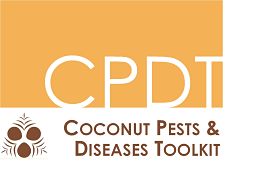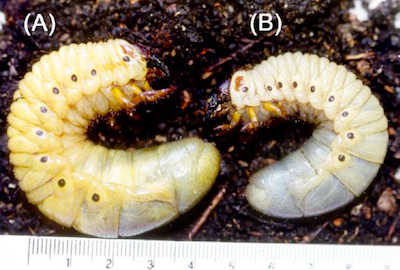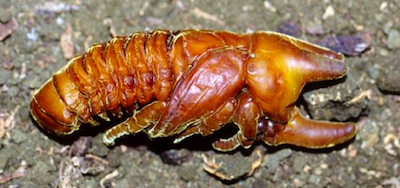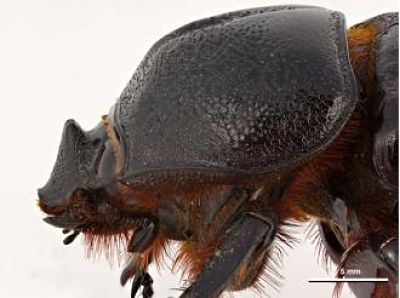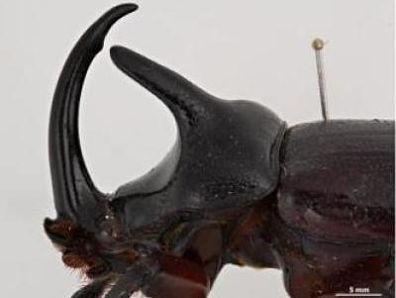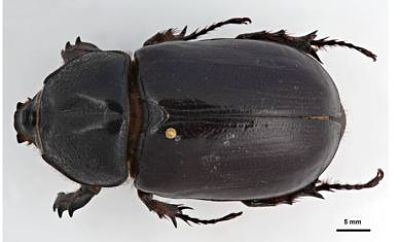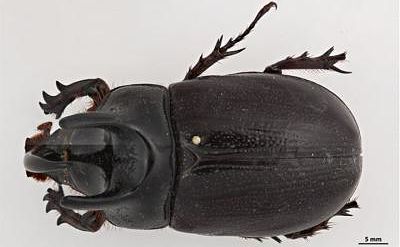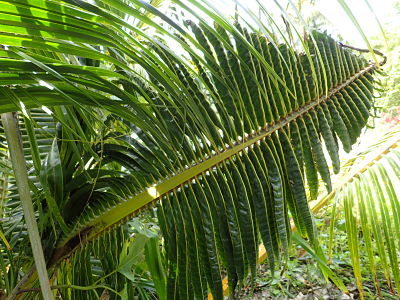Melanesian coconut rhinoceros beetle
The Melanesian coconut rhinoceros beetle is a serious pest insect of coconut within the Pacific. There is a high risk of outbreak.
Common nameMelanesian coconut rhinoceros beetle |
Scientific nameScapanes australis |
on this page: Life-cycle and identification : Symptoms : Impacts : Distribution : Prevention : Controlling Melanesian coconut rhinoceros beetle : Information sources and further reading
Life-cycle and identification
Melanesian coconut rhinoceros beetle includes one species and two sub-species: Scapanes australis and the sub-species Scapanes australis australis and Scapanes australis grossepunctatus.
Melanesian coconut rhinoceros beetle are beetles. Beetles have what is known as a complete metamorphic life cycle. This means they go through distinct changes, with body forms that are very different.
The four main stages of the beetle life-cycle are eggs, larvae, pupae and adults. Melanesian coconut rhinoceros beetle eggs are difficult to see. Identification of adults is much easier.
Moist organic humus under rotting tree logs and in dead tree stumps in the forest are preferred breeding habitats.
Melanesian coconut rhinoceros beetles rarely use dead palm logs and stumps, which are the preferred nesting habitat for Oryctes rhinoceros.
Eggs : Larvae : Pupae : Adults
Eggs
Melanesian coconut rhinoceros beetle eggs are 5 mm by 3 mm and and creamy-white in colour.
An average of 30 eggs are laid singularly and spread out within soil, rotten logs or other organic material. Eggs will become rounder and hatch after about 30 days.
LarvaeThe larvae are yellowy white, C-shaped grubs with red-brown to brown heads. Larvae do not feed in growing palms, but occur in moist organic humus under rotting tree logs and in dead tree stumps in the forest. They rarely occur in dead palm logs and stumps, which are the preferred habitat for Oryctes rhinoceros larvae. The grubs go through three growth stages (instars) within around 9 months, each stage being longer than the first stage. Before pupating the 3rd instar will reach a length of 10 cm by 2 cm in width. The grubs will then make a chamber of compacted soil or organic material in which to begin pupation. |
Pre-pupa (left) and younger 3rd instar (right) larvae (© Laurence Beaudoin-Ollivier, CIRAD) |
PupaeThe pre-pupal stage will last for around 15-30 days. The pre-pupa moults to a yellow-brown pupa which has many of the adult features. |
Pupa with distinct adult features (© Laurence Beaudoin-Ollivier, CIRAD) |
Adults
Adult Melanesian coconut rhinoceros beetle are the easiest life stage to identify. They are 4-6 cm long and black in colour and have a life span of about 4 months.
Females have a small double horn on their head.
Males have a pair of large horns on the back of their head and one distinct curved horn at the front of their head (see images below).
|
|
Adult male Melanesian coconut rhinoceros beetle (© Ken Walker, PaDIL) |
The adult beetles can be seen within the crown of the palm in tunnels they create.
Males are most frequently seen alone within these tunnels however males and females have been spotted together.
The beetles are strong fliers.
|
Adult female Melanesian coconut rhinoceros beetle (© Ken Walker, PaDIL)
|
Adult male Melanesian coconut rhinoceros beetle (© Ken Walker, PaDIL) |
Symptoms
|
Much like the Oryctes rhinoceros, the adult Melanesian coconut rhinoceros beetle chews or bores holes into the growing point of the frond and feeds on the soft tissues and juices within the developing frond. Once the damaged spear leaf has opened, fronds have distinct wedge or V-shaped patterns. However, unlike Oryctes rhinoceros, Melanesian coconut rhinoceros beetle usually only attacks young palms up to 5 years old. Attacks on tall palms are very uncommon. If the palm is not dead from severe attacks to the growing point, the fronds leaflets may look squeezed and crushed together while the fronds show twisting, nicks and truncation. The bored holes and tunnels filled with excreted material (insect droppings and plant matter) create an entry point for other pest insects such as termites and weevils, which can cause further damage. |
When attacked by Melanesian coconut rhinoceros beetle palm frond leaflets may look squeezed and crushed together while the fronds show twisting, nicks and truncation (© Department of Agriculture and Water Resources, Australia) |
Impacts
The impacts from Melanesian coconut rhinoceros beetle vary among species and sub-species.
East New Britain Province (Papua New Guinea) has reported that damage typically occurs in coconut plantations that are young and newly planted (less than ten years old). The sub-species Scapanes australis grossepunctatus in particular damages young and newly planted coconuts. The mainland subspecies Scapanes australis australis generally causes less damage.
Attacks are generally severe, even from a few beetles per hectare. A 10% or more mortality rate of newly planted palms deters farmers and families who rely on coconut for their livelihood. Planting, replanting and controlling the beetle is costly and time-consuming.
Melanesian CRB populations can flourish if plantations are established in forest clearings as the felled logs and cut organic materials create breeding sites. Fortunately, the larvae commonly live under fallen tree logs and do not affect palms.
The impact of Melanesian coconut rhinoceros beetle on commercial plantations is rarely significant. However, damage is often severe in newly established plantation areas, as clearing forest often creates breeding sites adjacent to the plantation in fallen timber and stumps. Damage in large plantation areas is often restricted to the edge of the plantation area.
Adults of Melanesian coconut rhinoceros beetle will also infest banana plants, usually resulting in the death of the damaged stem, and the beetle has been reported as damaging oil palm as well.
Secondary invasion is a major risk. The bored beetle holes invite other pest insects such as Black palm weevil, Rhynchophorus bilineatus whose grubs feeding damage can cause coconuts to die.
Distribution
Melanesian coconut rhinoceros beetle is widespread throughout Southeast Asia and Oceania. It is recorded from Papua New Guinea and Solomon Islands.
Scapanes australis australis and Scapanes australis grossepunctatus sub-species are found in Papua New Guinea.
Contact SPC for up-to-date information on Melanesian coconut rhinoceros beetle distributions.
Prevention
Most importantly, the International Guidelines for transfer of coconut germplasm should be strictly followed to prevent pests and diseases being moved to new locations.
For general information on preventing pests and diseases of coconut, see the Prevention section.
Controlling Melanesian coconut rhinoceros beetle
We strongly recommend an integrated pest management (IPM) approach to the control of all insects, where possible. This is a combination of methods (pesticides, physical controls such as site hygiene and biological controls) to minimise the use of pesticides and minimise the cost of control.
Integrated Pest Management (IPM)
The goal of IPM is to keep pest populations to a level below which they cause economic harm. IPM involves using multiple control options together for the economic control of pests (i.e. cultural, natural and chemical).
In an agricultural context the Food and Agriculture Organization defines IPM as "the careful consideration of all available pest control techniques and subsequent integration of appropriate measures that discourage the development of pest populations and keep pesticides and other interventions to levels that are economically justified and reduce or minimize risks to human health and the environment. IPM emphasizes the growth of a healthy crop with the least possible disruption to agro-ecosystems and encourages natural pest control mechanisms".
Even when adult numbers are low per hectare, damage can be severe making it hard to control them. There are a combination of methods to help reduce populations however and avoid outbreaks.
Cultural
For new coconut plantations, removing, breaking up and burning cut organic material (logs and stumps) will reduce larval breeding sites and minimise the number of adults damaging palms.
If planting of coconuts is within land newly cleared from forest, removing and burning cut organic material (especially logs) will reduce breeding sites and therefore subsequent attacks.
Planting of legume plant species such as Pueraria phaseolodes, Mucuna pruriens has been recommended in the past to conceal potential breeding sites that can not be removed. However, several experts consider that this approach is not helpful.
In Papua New Guinea, breeding sites occur in cocoa and coconut plantations associated with rotting stumps of shade tree (e.g. Gliricidia sepium). Breeding sites have also been found in old nests of megapodes, when these were near breadfruit trees.
When possible, a cost effective and less difficult method for smallholder farms, is to plant in already established plantations as breeding sites would have rotted or already been removed.
Planting resistant varieties is recommended. Papua New Guinea has reported fewer deaths of Gazelle Tall palms (compared to Rennell Tall, Rennell Tall X or Malayan Dwarf) which are fast-growing and will reach an age of less susceptibility sooner. Similar patterns have been observed on palms with the same characteristics on Solomon Islands.
NaturalBiological control agents have been investigated, but have not been effective as outbreaks are largely found in new plantations in recently cleared forest. Beauveria bassiana (white muscardine fungus) is a parasitic fungus infecting many insects. This has been seen growing on Melanesian coconut rhinoceros beetle, causing death, and may be a useful control. These fungi can be purchased in bulk online at websites such as alibaba.com. Oryctes rhinoceros nudivirus has not been shown to affect the Melanesian coconut rhinoceros beetle. The broad distribution of larvae in forested areas makes application of the virus impractical. |
Beauveria bassiana on an adult Melanesian coconut rhinoceros beetle (©Laurence Beaudoin-Ollivier, CIRAD) |
Chemical
Chemical controls such asbroadcast pesticides are not recommended due to their high cost, inefficiency and harm to non-target organisms.
Many previously used chemicals are now banned and it is recommended to contact your local or national government for advice if chemicals are thought to be necessary. Plantwise has included some useful guides to pesticides and their current regulations; EU pesticides database and PAN pesticide database.
The synthesised aggregation pheromone is currently the recommended control method alongside trapping as it attracts males and females. Contact SPC for more information on obtaining aggregation pheromones.
Research trials are in place looking at creating oviposition traps where adult females are attracted to oviposition sites (piles of rotting wood), and are then poisoned or otherwise killed. This avoids the negative consequences of broadcast use of pesticides and is consistent with an IPM approach.
Information sources and further reading
Bedford. 1976. Observations on the biology and ecology of Oryctes rhinoceros and Scapanes australis (Coleoptera: Scarabaeidae: Dynastinae): pests of coconut palms in Melanesia. Australian Journal of Entomology, 15(3), pp.241-251.
Bedford. 1980. Biology, ecology, and control of palm rhinoceros beetles. Annual Review of Entomology, 25(1), pp.309-339. Access required.
PaDIL. 2011. Melanesian rhinoceros beetle - (Scapanes australis australis). [ONLINE]
PestNet. 2017. Coconut rhinoceros beetle - Melanesian. [ONLINE]
Plantwise. 2018. Rhinoceros beetle (Scapanes australis). [ONLINE]
content reviewed by David Britton, Northern Australia Quarantine Strategy, Department of Agriculture and Water Resources, July 2018; Bob Macfarlane, Solomon Islands, September 2018
